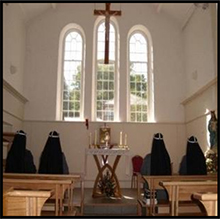Pilgrimage to Holywell and Lancashire

In April, 2018 ten members of our society went on pilgrimage to stay at the Convent of the Bridgettine Sisters at Holywell in North Wales. The Bridgettine Sisters was founded by Saint Bridget of Sweden in 1344 Their chief obligation is liturgical prayer, the regular daily Divine Office. They attend daily Mass and Adoration of the Blessed Sacrament.
(See picture of their chapel – above).
Central to the Sisters’ work is the “Guest House” in Holywell. The Sisters welcome to their house all who seek stillness and quiet. Their “Hospitality” is an answer to the needs of many pilgrims. The Bridgettine Sisters are established in three continents, in 65 houses.
Holywell has been a place of pilgrimage since the seventh century. It is the only shrine in Britain that can show an unbroken history of pilgrimage to the present day. The town gets its name from the shrine. We know not when the place first began to be called Holywell, probably very soon after the Saint’s death. The first mention of the place is about 1150. All through the middle ages, we are told, “devotees from all parts of Christendom” were in the habit of coming to the Well.

The healing waters have been said to cause miraculous cures. The legend of St. Winefrid tells how, in AD 660, Caradoc, the son of a local prince, severed the head of the young Winefred after she spurned his advances. A spring rose from the ground at the spot where her head fell and she was later restored to life by her uncle, Saint Beuno. The well is known as “the Lourdes of Wales”. It has been a pilgrimage site since the 7th century.
(Picture of the well and chapel above it – above)
Later, a shrine was established in Shrewsbury around 1138, it and St. Winefride’s Well became important pilgrimage destinations.

After visiting the well, we had Mass on the Feast of St. Mark, the evangelist in the chapel built above. (See picture – above). Afterwards, Fr. Jonathan Redvers Harris sprinkled the congregation (“Asperges” style) with water from the well.
A few miles from Holywell in the village of Pantasaph is the Franciscan Friary that is the national shrine of St. (Padre) Pio. People have been coming to here for 125 years on a constant spiritual journey. In 1852 the church of St. David’s, in Pantasaph was completed and, together with other buildings and surrounding land was given to the Franciscan Friars. The Friary became the mother house, where all young postulants in Britain came to begin their novitiate. The Order based at Pantasaph is the Capuchins and Padre Pio was also a Capuchin.
When the Brothers first arrived at Pantasaph, they offered God their sacrifice of praise and began working to make Pantasaph ‘a light on a hill’. A Calvary walk was established on the hilltop, with a zigzagging footpath leading through the stations of the cross up to it. Our Lady’s grotto was created on the lower slopes, with the rosary decades displayed along a Rosary walkway.
A large bronze statue of the saint has been erected near the shrine. For Padre Pio’s canonisation, 16th June 2002, a wooden statue was commissioned and blessed by Bishop Edwin Regan, to be sent out all across Britain as a pilgrim to visit people in their own churches and homes.

This year marks the 50th anniversary of St. (Padre) Pio’s death. He died on 23rd September (his feast day), 1968.

Lancashire had remained predominately Catholic throughout much of the penal times. Its distance from London meant that the laws against Catholics were not enforced with the same rigidity. When one adds the emigration from Ireland in Victorian times, it is easy to understand how the term Catholic Lancashire has evolved. Most Catholics in Lancashire were poor and living in conditions that we would not experience today; yet they were faithful to their religion and generous. It is often said that the “pennies of the poor contributed in no small way to the building of many of the Catholic churches of Lancashire. This is evident in Preston (“Priest’s town”), one of the most Catholic cities in England. The magnificent church of St. Walburge (picture – above) is probably the largest Catholic parish church in England. It was clearly built to accommodate a large Catholic congregation. Sadly, many of our churches have today found that their congregations have dwindled as the people move from city centres and the number of church attendees has dropped radically. Consequently, it is not surprising that a number of English bishops are looking to hand redundant churches over to religious Orders. This has happened in Preston at both St. Walburge’s and the English Martyrs Church, not far away. Both churches have been given to the “Institute of Christ the King, a Society of Apostolic Life, founded in 1990. The Institute is a missionary society devoted to promoting the reign of Christ the King in every aspect of human life. In addition to the canons of the Institute and the seminarians in formation, the Institute also includes brothers (called ‘oblates’), who offer their talents to God without going on to the priesthood, and a branch of contemplative sisters called the Adorers of the Royal Heart of Jesus. In keeping with its charism of fostering the union of faith and culture and promoting sacred art for the glory of God. At Preston the Institute faces a daunting task of restoring this magnificent church and attracting a larger congregation. Fr. Christopholi, the rector, is a young and enthusiastic priest. When he met our group at the church for a guided tour, we were struck by his energy and enthusiasm. He works with two other Institute priests and three nuns. The Institute (ICKSP) is also dedicated to the traditional liturgy. We were impressed by the age of their clergy; in their 20s and 30s. This counters the attitude amongst many Catholics that only the elderly are interested in the traditional liturgy. In fact, there is an increasing amount of evidence to prove that the opposite is true.
The church was built by Joseph Hansom, the famous gothic style Catholic architect, who was inspired by Pugin. One of his earliest churches was our own St. Mary’s in Ryde (1846). Hansom went on to design many Catholic churches and several cathedrals. The 309-foot spire, dominating the Preston skyline, is the third tallest in the country.

There is a similar story in New Brighton on the south west side of the Mersey, just across from Liverpool. This unique church, once again built by the pennies of the poor and the drive and determination of an Irish priest, Fr. Thomas Mullins, and opened in 1935. Built on a small hill and dedicated to Sts, Peter and Paul and St. Philomena. (See picture – above). This large church with distinctive dome is a familiar sight. Originally planned to match the cathedral at Liverpool on the other side of the Mersey with striking domes, this did not materialise when the war delayed the building cathedral and the plans were changed to produce the “Paddy’s wigwam” cathedral that we have today. The church is known as the Dome of Home, as often it was the first sight on the horizon that sailors saw as they approached Liverpool.
Like St. Walburge’s, the congregation has declined and the Diocesan authorities are left with a huge, almost empty church. Sensibly, it has now been placed under the stewardship of the Institute of Christ the King. This is a welcome and pragmatic step that we hope will evolve in other diocese across the country.
After a guided tour of this church, Fr. Jonathan offered Mass for us in the Day chapel. Afterwards we met Canon Montjean, the rector, who had arranged a splendid buffet lunch for us
Another large city centre church, this time in Warrington, is that of St.Mary’s Priory. It is a beautiful and ornate church is now in the care of the Society of St. Peter (FSSP). The parish was established and served by Benedictine monks from Ampleforth Abbey, but following the withdrawal of Ampleforth Abbey from the parish in 2012, it was served by the priests from St Benedict’s Church, Warrington. It is now a shrine church dedicated to the celebration of the Sacraments in the E.F. Form.
The Fraternity of St. Peter is a Clerical Society of Apostolic Life of Pontifical right founded by Pope St John Paul II in 1988, following the division in the Society of St. Pius X (SSPX), as a result of Archbishop Lefebvre’s consecration of bishops, without papal approval. The Fraternity has always had a close association with many of us on the Isle of Wight. It has a two-fold mission: firstly, the formation and sanctification of priests; and secondly, the pastoral deployment of the priests in the service of the Church (currently serving in 129 dioceses on 5 continents). The Fraternity’s priests are devoted exclusively to the Traditional Liturgy of the Roman Rite. They have been regular visitors to the Island offering Mass, visiting the sick and housebound and giving Days of Recollection.

Fr. Armand de Malleray (custodian of this shrine) is well known to many of us here on the Island. He has offered Mass on the Island at Ryde, Quarr Abbey and Newport. Another priest here at the Shrine in Warrington is Fr. Konrad Lowenstein, who came to offer Mass at Holy Cross, Seaview shortly after his Ordination in 2003. He also visited St. Cecilia’s Abbey where two of his cousins were nuns. (See picture of our group with the priests – above)
We were delighted to meet up again with both priests. After a guided tour of the church, we attended Mass and had the opportunity to avail ourselves of the Sacrament of Penance. Here a priest is available for Confession for 30 minutes before every Mass.

In an afternoon in Liverpool we visited the Metropolitan Cathedral, where Pope John Paul II offered Mass on the evening of Pentecost Sunday, 1982. The war curtailed plans for the building of an earlier cathedral. The present structure was completed in 1967. This is a modern, contemporary style, in complete contrast to everything else that we saw on our pilgrimage, yet, nevertheless, it is functional and appropriate for today’s liturgical celebrations. On the journey home the group stopped off for lunch in Oxford, where they visited the Oxford Oratory. (See picture – above).
Built in 1875 (once again by Joseph Hansom), it is dedicated to St. Aloysius. It was founded as the Jesuit parish and was served by notable members of the society for many years, including Gerard Manley Hopkins. In 1990 it was placed into the custody of the Oratorians. It is famous for its high standard of liturgy and music in the Mass.
See more pictures of this pilgrimage in our Gallery – Pilgrimage page.